
The Volkswagen Passat is a nameplate of large family cars (D-segment) manufactured and marketed by the German automobile manufacturer Volkswagen since 1973. It has been marketed variously as the Dasher, Santana, Quantum, Magotan, Corsar and Carat, with varying body styles such as saloon, estate, and hatchback.
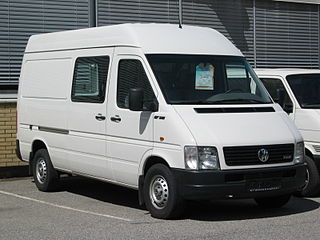
The Volkswagen LT is the largest light commercial panel van produced by Volkswagen from 1975 to 2006, before being replaced by the Crafter. Two generations were produced.
A W8 engine is an eight-cylinder piston engine with four banks of two cylinders each, arranged in a W configuration.
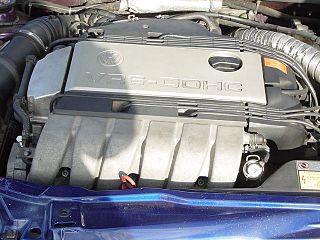
The VR6 engine is a six-cylinder engine configuration developed by VW. The name VR6 comes from the combination of German words “Verkürzt” and “Reihenmotor” meaning “shortened inline engine”. It was developed specifically for transverse engine installations and FWD vehicles. The VR6 is a highly compact engine, thanks to the narrower angle of 10.5 to 15 degrees between cylinder banks, as opposed to the traditional V6 angles ranging from 45 to 90 degrees. The compact design is cheaper to manufacture, since only one cylinder head is required for all six cylinders, much like a traditional inline-6 engine.
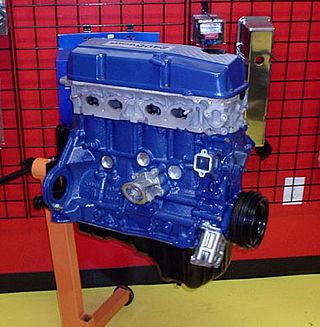
The KA engines were a series of four-stroke inline-four gasoline piston engines manufactured by Nissan, which were offered in 2.0 and 2.4 L. The engines blocks were made of cast-iron, while the cylinder heads were made of aluminum.

The Toyota K series is an inline-four engine that was produced from 1966 through 2007. It is a two-valve pushrod engine design. It was originally built from the Toyota Kamigo plant in Toyota City factory in Japan.
The Hyundai Sirius engine was the company's first larger inline-four engine, with displacements from 1.8 L to 2.4 L. It is a license-built Mitsubishi construction. This engine is no longer used by Hyundai.
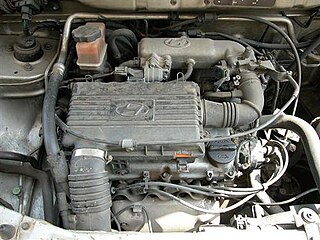
Hyundai's Epsilon engine is a category of small inline gasoline automobile engines.
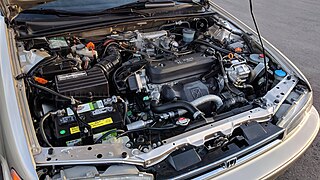
The Honda F-Series engine was considered Honda's "big block" SOHC inline four, though lower production DOHC versions of the F-series were built. It features a solid iron or aluminum open deck cast iron sleeved block and aluminum/magnesium cylinder head.

The Volkswagen G60 and G40 were inline–four-cylinder automobile petrol engines, which used a specific method of forced induction by way of a scroll-type supercharger. The G60 engine was formerly manufactured by the German automaker Volkswagen Group and was installed in a limited number of their 'hot hatch' cars from their Volkswagen Passenger Cars marque from August 1988 to July 1993.

The Mitsubishi 3G8 engine is a range of three-cylinder powerplant from Mitsubishi Motors, introduced in the fifth generation of their Mitsubishi Minica kei car. In common with other contemporary engines in the class, it could be specified with many advanced technologies despite its diminutive size, including multi-valve cylinder heads and double overhead camshafts. The top-of-the-line Dangan ZZ variant was also the first kei car to benefit from turbocharging. In 1987 Mitsubishi was the first manufacturer to supercharge a kei vehicle, and in 1989 became the world's first production car to feature five valves per cylinder, ahead of similar developments by Bugatti, Audi, Ferrari and Toyota.
The VR5 engines are a family of petroleum fuelled Internal combustion engines developed by the Volkswagen Group and produced from 1997 to 2006. They are derived from the VR6 engine family, also developed by Volkswagen, but with one fewer cylinders. The VR5 is highly compact, thanks to the narrower angle of 15° and a displacement of 2,324 cc. The VR5 was the first production block to use five cylinders in a VR design with a 15-degree angle.

Volkswagen R is the brand used by the German auto manufacturer Volkswagen to indicate a sport or high performance model. An "R" badge is placed on the grille, front fenders and trunk of R-model vehicles to indicate the vehicle's trim level.

The Volkswagen EA211 engine, also called modular gasoline engine kit, is a family of inline-three and inline-four petrol engines with variable valve timing developed by Volkswagen Group in 2011. They all include a four-stroke engine and dual overhead camshaft drive into exhaust manifolds. In 2023 Škoda Auto a.s. took control over EA211 development, which they have already produced in Mladá Boleslav since 2012.

Volkswagen Group have produced a number of W12 internal combustion piston engines for their Volkswagen, Audi, and Bentley marques, since 2001.

The Volkswagen-Audi V8 engine family is a series of mechanically similar, gasoline-powered and diesel-powered, V-8, internal combustion piston engines, developed and produced by the Volkswagen Group, in partnership with Audi, since 1988. They have been used in various Volkswagen Group models, and by numerous Volkswagen-owned companies. The first spark-ignition gasoline V-8 engine configuration was used in the 1988 Audi V8 model; and the first compression-ignition diesel V8 engine configuration was used in the 1999 Audi A8 3.3 TDI Quattro. The V8 gasoline and diesel engines have been used in most Audi, Volkswagen, Porsche, Bentley, and Lamborghini models ever since. The larger-displacement diesel V8 engine configuration has also been used in various Scania commercial vehicles; such as in trucks, buses, and marine (boat) applications.

















